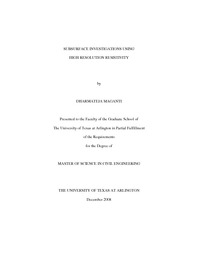
ATTENTION: The works hosted here are being migrated to a new repository that will consolidate resources, improve discoverability, and better show UTA's research impact on the global community. We will update authors as the migration progresses. Please see MavMatrix for more information.
Show simple item record
| dc.contributor.author | Maganti, Dharmateja | en_US |
| dc.date.accessioned | 2008-09-17T23:35:16Z | |
| dc.date.available | 2008-09-17T23:35:16Z | |
| dc.date.issued | 2008-09-17T23:35:16Z | |
| dc.date.submitted | August 2008 | en_US |
| dc.identifier.other | DISS-2270 | en_US |
| dc.identifier.uri | http://hdl.handle.net/10106/1143 | |
| dc.description.abstract | Electrical resistivity imaging has been proved to be well suited to produce images of subsurface conditionsbecause of the ability of the technique for detecting resistive features and discriminating subtle resistivity variations in the soil media. Electrical resistivity imaging survey was performed at E. Center Development in Duncanville, Texas. The survey was conducted using SuperSting R8/IP Multi-channel Resistivity Imaging System to image the subsurface structure. Both 2-D and 3-D electrical resistivity imaging tests were conducted using dipole-dipole array at 2 feet, 5 feet and 20 feet electrode spacing. Earth Imager 2D and Earth Imager 3D software's were then used to invert the apparent resistivity data.
Three soil test borings were drilled in the site, to confirm and verify the actual subsurface information. The results obtained from resistivity imaging were confirmed by all three soil test borings. | en_US |
| dc.description.sponsorship | Hossain, Sahadat | en_US |
| dc.language.iso | EN | en_US |
| dc.publisher | Civil & Environmental Engineering | en_US |
| dc.title | Subsurface Investigations Using High Resolution Resistivity | en_US |
| dc.type | M.S.C.E. | en_US |
| dc.contributor.committeeChair | Hossain, Sahadat | en_US |
| dc.degree.department | Civil & Environmental Engineering | en_US |
| dc.degree.discipline | Civil & Environmental Engineering | en_US |
| dc.degree.grantor | University of Texas at Arlington | en_US |
| dc.degree.level | masters | en_US |
| dc.degree.name | M.S.C.E. | en_US |
| dc.identifier.externalLink | https://www.uta.edu/ra/real/editprofile.php?onlyview=1&pid=963 | |
| dc.identifier.externalLinkDescription | Link to Research Profiles | |
Files in this item
- Name:
- umi-uta-2270.pdf
- Size:
- 8.911Mb
- Format:
- PDF
This item appears in the following Collection(s)
Show simple item record


